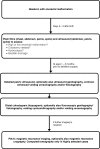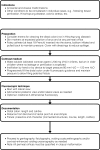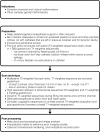European Society of Paediatric Radiology abdominal imaging task force recommendations in paediatric uroradiology, part IX: Imaging in anorectal and cloacal malformation, imaging in childhood ovarian torsion, and efforts in standardising paediatric uroradiology terminology
- PMID: 28852767
- PMCID: PMC5574969
- DOI: 10.1007/s00247-017-3837-6
European Society of Paediatric Radiology abdominal imaging task force recommendations in paediatric uroradiology, part IX: Imaging in anorectal and cloacal malformation, imaging in childhood ovarian torsion, and efforts in standardising paediatric uroradiology terminology
Abstract
At the occasion of the European Society of Paediatric Radiology (ESPR) annual meeting 2015 in Graz, Austria, the newly termed ESPR abdominal (gastrointestinal and genitourinary) imaging task force set out to complete the suggestions for paediatric urogenital imaging and procedural recommendations. Some of the last missing topics were addressed and proposals on imaging of children with anorectal and cloacal malformations and suspected ovarian torsion were issued after intense discussions and a consensus finding process that considered all evidence. Additionally, the terminology was adapted to fit new developments introducing the term pelvicalyceal dilatation/distension (PCD) instead of the sometimes misunderstood hydronephrosis. The present state of paediatric urogenital radiology was discussed in a dedicated minisymposium, including an attempt to adapt terminology to create a standardised glossary.
Keywords: Anorectal malformation; Child; Cloaca; Consensus; Diagnostic procedures; Fistolography; Fluoroscopy; Genitography; Guidelines; Imaging recommendations; Magnetic resonance imaging; Ovarian torsion; Pelvicalyceal dilatation; Terminology; Ultrasound.
Conflict of interest statement
None.
Figures












Comment in
-
Reply to Reck-Burneo et al.: imaging anorectal and cloacal malformations.Pediatr Radiol. 2018 Mar;48(3):445. doi: 10.1007/s00247-018-4075-2. Epub 2018 Jan 15. Pediatr Radiol. 2018. PMID: 29335881 No abstract available.
-
Imaging in anorectal and cloacal malformations.Pediatr Radiol. 2018 Mar;48(3):443-444. doi: 10.1007/s00247-017-4040-5. Epub 2018 Jan 23. Pediatr Radiol. 2018. PMID: 29362837 No abstract available.
References
General and relevant task force literature
-
- Fernbach SK, Maizels M, Conway JJ (1993) Ultrasound grading of hydronephrosis: introduction to the system used by the Society for Fetal Urology. Pediatr Radiol 23:478–480 - PubMed
-
- Riccabona M. Paediatric urogenital imaging today – the old and the new stuff for daily needs. Post-congress minisymposium at 52nd ESPR annual meeting and postgraduate course, 2-6 June, Graz. Austria. Pediatr Radiol. 2015;45(S2):S319–S321.
-
- Riccabona M, Darge K, Lobo ML, et al. ESPR Uroradiology Task Force – imaging recommendations in paediatric uroradiology, part VIII: retrograde urethrography, imaging disorders of sexual development, and imaging in childhood testicular torsion. Pediatr Radiol. 2015;45:2023–2028. doi: 10.1007/s00247-015-3452-3. - DOI - PMC - PubMed
-
- Riccabona M, Vivier HP, Ntoulj A, et al. ESPR Uroradiology Task Force – imaging recommendations in paediatric uroradiology - part VII: standardised terminology, impact of existing recommendations, and update on contrast-enhanced ultrasound of the paediatric urogenital tract. Pediatr Radiol. 2014;44:1478–1484. doi: 10.1007/s00247-014-3135-5. - DOI - PubMed
Selected literature on anorectal and cloacal malformations and respective imaging procedures
Selected literature on childhood ovarian torsion
-
- Bronstein ME, Pandya S, Snyder CW, et al. A meta-analysis of B-mode ultrasound, Doppler ultrasound, and computed tomography to diagnose pediatric ovarian torsion. Eur J Pediatr Surg. 2015;25:82–86. - PubMed
Publication types
MeSH terms
LinkOut - more resources
Full Text Sources
Other Literature Sources
Medical

